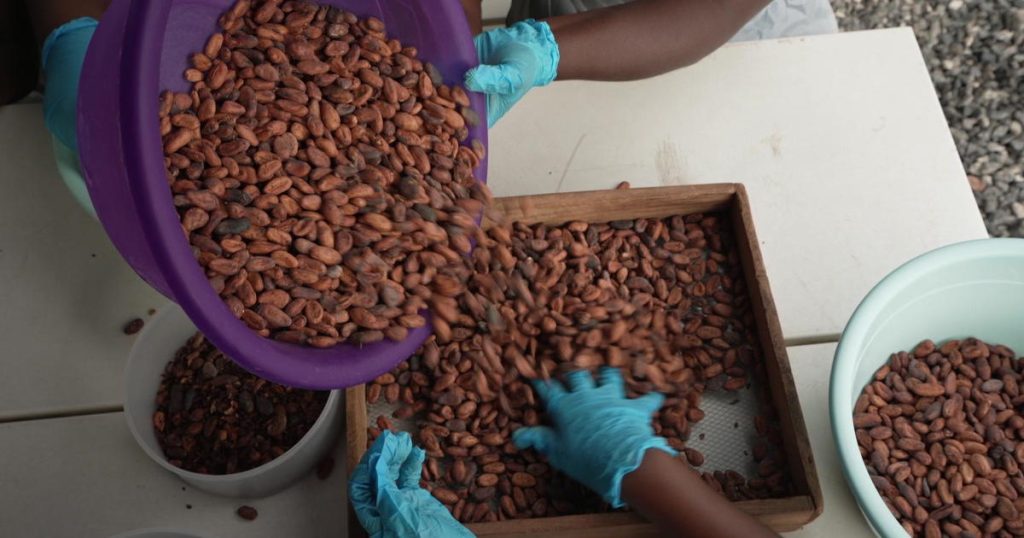Climate Change and the Future of Chocolate
As Valentine’s Day approaches, the world’s love affair with chocolate is reignited, but the industry faces a growing challenge: climate change is threatening cacao production, particularly in West Africa, which supplies approximately 70% of the world’s cocoa beans. Rising temperatures and shifting rainfall patterns are disrupting cacao crops, affecting both the quantity and quality of beans. This disruption is driving up chocolate prices for consumers. According to the United Nations Conference on Trade and Development (UNCTAD), cocoa prices surged by 136% between July 2022 and February 2024, with the price per metric ton crossing $10,000 for the first time in March 2023. The United Nations trade agency attributes these increases, in part, to the impacts of climate change.
The Rising Cost of Chocolate
The surge in cocoa prices is not just a temporary blip but part of a larger trend influenced by climate change. West African countries, particularly Ghana and Côte d’Ivoire, have long been the heart of global cocoa production, accounting for around 3.48 million metric tons of cocoa beans in the 2022-2023 season. This output is vital to the global chocolate industry, where approximately 400 cocoa beans are needed to produce just one pound of chocolate. Millions of farmers rely on cacao for their livelihoods, with cocoa production in Ghana alone employing 3.2 million farmers and workers—more than 10% of the country’s population. However, as temperatures rise and rainfall patterns become more unpredictable, the future of these livelihoods is under threat. Emmanuel Essah-Mensah, a cocoa farmer from Ghana, warns, “Climate change is threatening the existence of cocoa farmers and their sources of livelihoods.”
The Science Behind the Crisis
A new analysis by scientists at Climate Central, a nonprofit research organization, has shed light on how climate change is pushing temperatures beyond the optimal range for cacao trees in West Africa. This study is the first of its kind to quantify the impact of human activities and climate change on cocoa production in the region. Cacao trees thrive in temperatures up to 32 degrees Celsius (89.6 Fahrenheit), but recent data shows that climate change is increasing the number of days above this threshold. Over the past decade, approximately two-thirds of West Africa’s cacao-growing regions have experienced at least six additional weeks of days each year with temperatures exceeding the ideal range, while one-third of the regions have seen eight or more additional weeks of excessive heat.
The Impact of Rising Temperatures
Excessive heat is devastating for cacao production. Cacao plants rely on stable temperatures for proper photosynthesis, and too many hot days can disrupt this process, leading to shriveled flowers and smaller, rotting pods. The effect is compounded by the fact that cacao trees are highly sensitive to environmental changes. In Western Africa, cacao is typically harvested during two main periods: the main crop from September to March and the mid-crop from May to August. After flowering, it takes about five to six months for the pods to mature. Once ripe, the pods are hand-harvested, split open to extract the seeds, and then fermented and dried to develop the flavors essential for chocolate production. However, as temperatures rise, this delicate process is being disrupted, leading to lower yields and poorer quality beans.
Rainfall Patterns and Their Role in the Crisis
The impact of climate change extends beyond heat stress. Cacao trees are also highly sensitive to rainfall patterns. According to the International Cocoa Organization, cacao thrives in regions with annual rainfall totals of 1,500 to 2,000 millimeters (about 59 to 79 inches) and no dry spells longer than three months. However, erratic rainfall is becoming more common in West Africa. For example, in July 2024, parts of Côte d’Ivoire experienced 40% more rainfall than usual, flooding fields and damaging crops. Conversely, in December of the same year, the region saw little rain, which slowed photosynthesis and resulted in fewer flowers and underdeveloped beans. These unpredictable growing conditions are leaving farmers with lower harvests and higher costs, further driving up chocolate prices.
Adapting to a Changing Climate
To address these challenges, some farmers are turning to diverse, nature-friendly agricultural practices. Strategies include planting taller trees between cacao plants to provide shade, improving soil health to retain moisture, and implementing other climate-resilient methods. These approaches aim to protect cacao plants from excessive heat and erratic rainfall. However, such strategies are not foolproof and require time to implement. The future of cacao farming in a warming world remains uncertain, and ongoing challenges threaten to continue driving up the price of chocolate. As the world celebrates Valentine’s Day, the beloved sweet treat may become even pricier, making it harder for consumers to enjoy their favorite indulgence.















